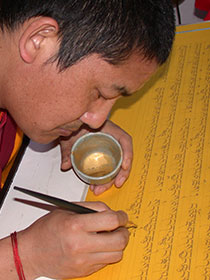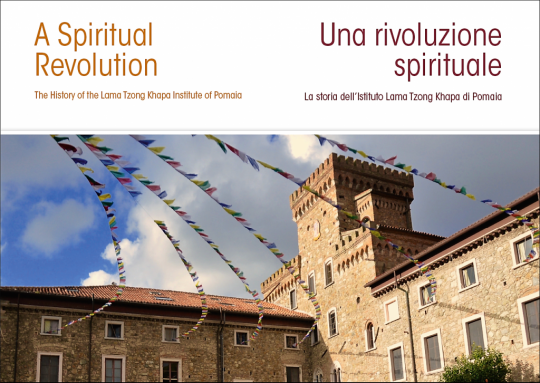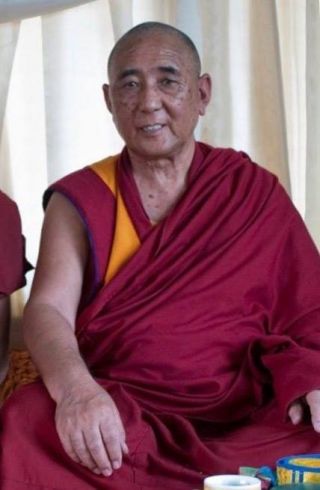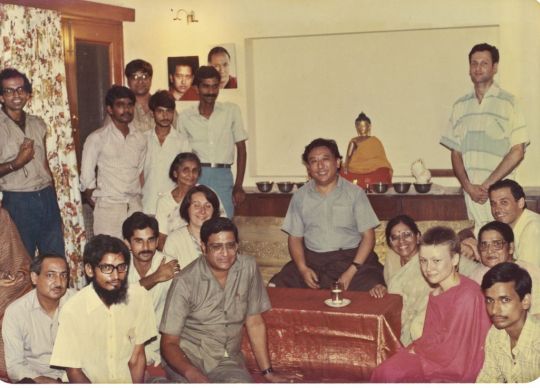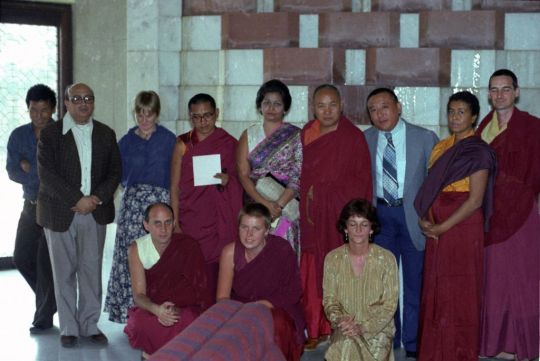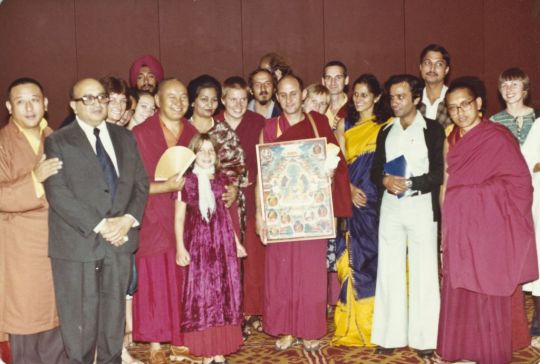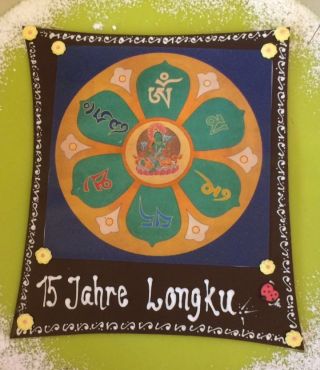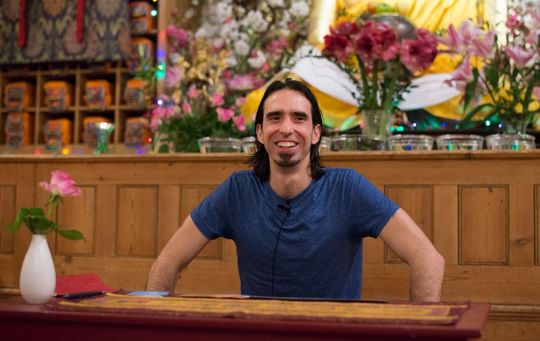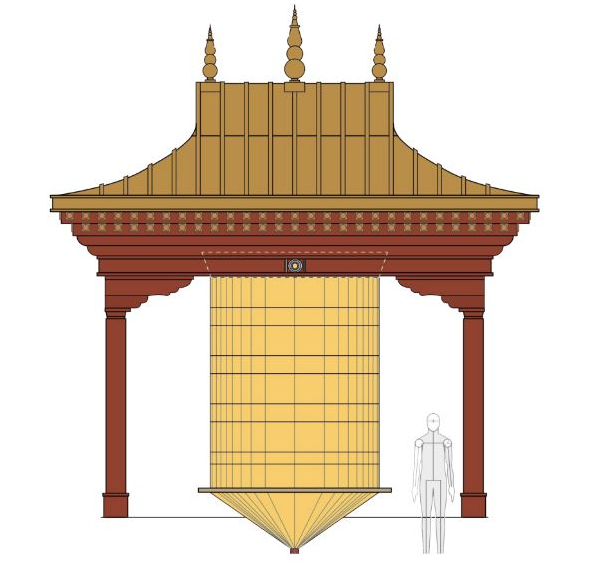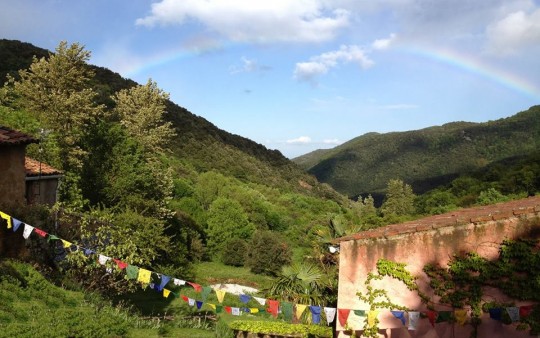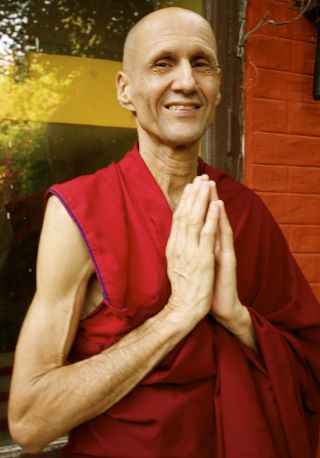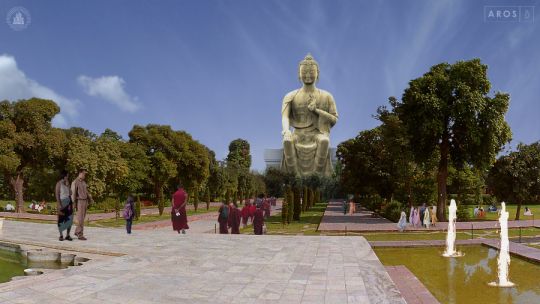- Home
- FPMT Homepage
Foundation for the Preservation of the Mahayana Tradition
The FPMT is an organization devoted to preserving and spreading Mahayana Buddhism worldwide by creating opportunities to listen, reflect, meditate, practice and actualize the unmistaken teachings of the Buddha and based on that experience spreading the Dharma to sentient beings. We provide integrated education through which people’s minds and hearts can be transformed into their highest potential for the benefit of others, inspired by an attitude of universal responsibility and service. We are committed to creating harmonious environments and helping all beings develop their full potential of infinite wisdom and compassion. Our organization is based on the Buddhist tradition of Lama Tsongkhapa of Tibet as taught to us by our founders Lama Thubten Yeshe and Lama Thubten Zopa Rinpoche.
- Willkommen
Die Stiftung zur Erhaltung der Mahayana Tradition (FPMT) ist eine Organisation, die sich weltweit für die Erhaltung und Verbreitung des Mahayana-Buddhismus einsetzt, indem sie Möglichkeiten schafft, den makellosen Lehren des Buddha zuzuhören, über sie zur reflektieren und zu meditieren und auf der Grundlage dieser Erfahrung das Dharma unter den Lebewesen zu verbreiten.
Wir bieten integrierte Schulungswege an, durch denen der Geist und das Herz der Menschen in ihr höchstes Potential verwandelt werden zum Wohl der anderen – inspiriert durch eine Haltung der universellen Verantwortung und dem Wunsch zu dienen. Wir haben uns verpflichtet, harmonische Umgebungen zu schaffen und allen Wesen zu helfen, ihr volles Potenzial unendlicher Weisheit und grenzenlosen Mitgefühls zu verwirklichen.
Unsere Organisation basiert auf der buddhistischen Tradition von Lama Tsongkhapa von Tibet, so wie sie uns von unseren Gründern Lama Thubten Yeshe und Lama Thubten Zopa Rinpoche gelehrt wird.
- Bienvenidos
La Fundación para la preservación de la tradición Mahayana (FPMT) es una organización que se dedica a preservar y difundir el budismo Mahayana en todo el mundo, creando oportunidades para escuchar, reflexionar, meditar, practicar y actualizar las enseñanzas inconfundibles de Buda y en base a esa experiencia difundir el Dharma a los seres.
Proporcionamos una educación integrada a través de la cual las mentes y los corazones de las personas se pueden transformar en su mayor potencial para el beneficio de los demás, inspirados por una actitud de responsabilidad y servicio universales. Estamos comprometidos a crear ambientes armoniosos y ayudar a todos los seres a desarrollar todo su potencial de infinita sabiduría y compasión.
Nuestra organización se basa en la tradición budista de Lama Tsongkhapa del Tíbet como nos lo enseñaron nuestros fundadores Lama Thubten Yeshe y Lama Zopa Rinpoche.
A continuación puede ver una lista de los centros y sus páginas web en su lengua preferida.
- Bienvenue
L’organisation de la FPMT a pour vocation la préservation et la diffusion du bouddhisme du mahayana dans le monde entier. Elle offre l’opportunité d’écouter, de réfléchir, de méditer, de pratiquer et de réaliser les enseignements excellents du Bouddha, pour ensuite transmettre le Dharma à tous les êtres. Nous proposons une formation intégrée grâce à laquelle le cœur et l’esprit de chacun peuvent accomplir leur potentiel le plus élevé pour le bien d’autrui, inspirés par le sens du service et une responsabilité universelle. Nous nous engageons à créer un environnement harmonieux et à aider tous les êtres à épanouir leur potentiel illimité de compassion et de sagesse. Notre organisation s’appuie sur la tradition guéloukpa de Lama Tsongkhapa du Tibet, telle qu’elle a été enseignée par nos fondateurs Lama Thoubtèn Yéshé et Lama Zopa Rinpoché.
Visitez le site de notre Editions Mahayana pour les traductions, conseils et nouvelles du Bureau international en français.
Voici une liste de centres et de leurs sites dans votre langue préférée
- Benvenuto
L’FPMT è un organizzazione il cui scopo è preservare e diffondere il Buddhismo Mahayana nel mondo, creando occasioni di ascolto, riflessione, meditazione e pratica dei perfetti insegnamenti del Buddha, al fine di attualizzare e diffondere il Dharma fra tutti gli esseri senzienti.
Offriamo un’educazione integrata, che può trasformare la mente e i cuori delle persone nel loro massimo potenziale, per il beneficio di tutti gli esseri, ispirati da un’attitudine di responsabilità universale e di servizio.
Il nostro obiettivo è quello di creare contesti armoniosi e aiutare tutti gli esseri a sviluppare in modo completo le proprie potenzialità di infinita saggezza e compassione.
La nostra organizzazione si basa sulla tradizione buddhista di Lama Tsongkhapa del Tibet, così come ci è stata insegnata dai nostri fondatori Lama Thubten Yeshe e Lama Zopa Rinpoche.
Di seguito potete trovare un elenco dei centri e dei loro siti nella lingua da voi prescelta.
- 欢迎 / 歡迎
简体中文
“护持大乘法脉基金会”( 英文简称:FPMT。全名:Foundation for the Preservation of the Mahayana Tradition) 是一个致力于护持和弘扬大乘佛法的国际佛教组织。我们提供听闻,思维,禅修,修行和实证佛陀无误教法的机会,以便让一切众生都能够享受佛法的指引和滋润。
我们全力创造和谐融洽的环境, 为人们提供解行并重的完整佛法教育,以便启发内在的环宇悲心及责任心,并开发内心所蕴藏的巨大潜能 — 无限的智慧与悲心 — 以便利益和服务一切有情。
FPMT的创办人是图腾耶喜喇嘛和喇嘛梭巴仁波切。我们所修习的是由两位上师所教导的,西藏喀巴大师的佛法传承。
繁體中文
護持大乘法脈基金會”( 英文簡稱:FPMT。全名:Found
ation for the Preservation of the Mahayana Tradition ) 是一個致力於護持和弘揚大乘佛法的國際佛教組織。我們提供聽聞, 思維,禪修,修行和實證佛陀無誤教法的機會,以便讓一切眾生都能 夠享受佛法的指引和滋潤。 我們全力創造和諧融洽的環境,
為人們提供解行並重的完整佛法教育,以便啟發內在的環宇悲心及責 任心,並開發內心所蘊藏的巨大潛能 — 無限的智慧與悲心 – – 以便利益和服務一切有情。 FPMT的創辦人是圖騰耶喜喇嘛和喇嘛梭巴仁波切。
我們所修習的是由兩位上師所教導的,西藏喀巴大師的佛法傳承。 察看道场信息:
- FPMT Homepage
- News/Media
-
- Study & Practice
-
-
- About FPMT Education Services
- Latest News
- Programs
- New to Buddhism?
- Buddhist Mind Science: Activating Your Potential
- Heart Advice for Death and Dying
- Discovering Buddhism
- Living in the Path
- Exploring Buddhism
- FPMT Basic Program
- FPMT Masters Program
- FPMT In-Depth Meditation Training
- Maitripa College
- Lotsawa Rinchen Zangpo Translator Program
- Universal Education for Compassion & Wisdom
- Online Learning Center
-
- Prayers & Practice Materials
- Overview of Prayers & Practices
- Full Catalogue of Prayers & Practice Materials
- Explore Popular Topics
- Benefiting Animals
- Chenrezig Resources
- Death & Dying Resources
- Lama Chopa (Guru Puja)
- Lama Zopa Rinpoche: Compendium of Precious Instructions
- Lama Zopa Rinpoche: Life Practice Advice
- Lama Zopa Rinpoche Practice Series
- Lamrim Resources
- Mantras
- Prayer Book Updates
- Purification Practices
- Sutras
- Thought Transformation (Lojong)
- Audio Materials
- Dharma Dates - Tibetan Calendar
- Translation Services
- Publishing Services
- Ways to Offer Support
- Prayers & Practice Materials
-
- Teachings and Advice
- Find Teachings and Advice
- Lama Zopa Rinpoche Advice Page
- Lama Zopa Rinpoche: Compendium of Precious Instructions
- Lama Zopa Rinpoche Video Teachings
- ༧སྐྱབས་རྗེ་བཟོད་པ་རིན་པོ་ཆེ་མཆོག་ནས་སྩལ་བའི་བཀའ་སློབ་བརྙན་འཕྲིན།
- Podcasts
- Lama Yeshe Wisdom Archive
- Buddhism FAQ
- Dharma for Young People
- Resources on Holy Objects
- Teachings and Advice
-
-
*If a menu item has a submenu clicking once will expand the menu clicking twice will open the page.
-
-
- Centers
-
- Teachers
-
- Projects
-
-
-
-
*If a menu item has a submenu clicking once will expand the menu clicking twice will open the page.
-
-
- FPMT
-
-
-
-
-
Actions that give harm to other sentient beings aren’t those of a bodhisattva. In Buddhism, there’s no such thing as a holy war. You have to understand this. It’s impossible to equalize everybody on earth through force.
Lama Thubten Yeshe
-
-
-
- Shop
-
-
-
The Foundation Store is FPMT’s online shop and features a vast selection of Buddhist study and practice materials written or recommended by our lineage gurus. These items include homestudy programs, prayers and practices in PDF or eBook format, materials for children, and other resources to support practitioners.
Items displayed in the shop are made available for Dharma practice and educational purposes, and never for the purpose of profiting from their sale. Please read FPMT Foundation Store Policy Regarding Dharma Items for more information.
-
-
FPMT News Around the World
28
In December 2016, Istituto Lama Tzong Khapa (ILTK) published A Spiritual Revolution: The History of the Lama Tzong Khapa Institute of Pomaia (in Italian, Una rivoluzione spirituale: La storia dell’Istituto Lama Tzong Khapa di Pomaia). The 120-page hardcover coffee table book features the story of ILTK’s 1976 founding and dozens of photos. Author Massimo Corona shared with Mandala some early memories of Istituto Lama Tzong Khapa’s founding in celebration of the new book:
When I met Lama Yeshe at Kopan in Nepal I was twenty-four years old. It was April 1971—forty-six years ago. I had without a doubt met my root guru. His words were, using an expression he himself coined, like “an atomic bomb entering [my] heart.”
The energy of the early days is unmatched. I remember working through the night to prepare the old rooms at ILTK for Lama Yeshe’s and Lama Zopa Rinpoche’s first meditation course. In those first three years as a director I learned a bit also about plumbing and plastering, although not always very successfully. In fact, I think around ’83 or ’84, a pipe in the Lamas’ residence broke and the house was completely flooded.
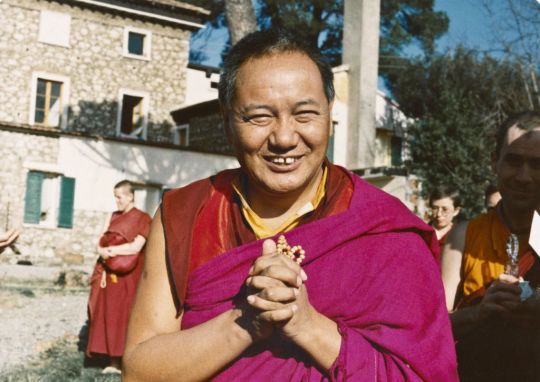
Lama Yeshe, Istituto Lama Tzong Khapa, Pomaia, Italy, 1983. Photo by Merry Colony, courtesy of Lama Yeshe Wisdom Archive.
A Spiritual Revolution captures the evolution of Istituto Lama Tzong Khapa after that first meeting in Nepal. Now that I’m back in Pomaia after spending many years in the United States and Mongolia, I’m amazed to see the progress the center has made. Every weekend there are at least one hundred people attending courses. During the week there are the Masters Program and the Basic Program, both being hosted for a third time. Between the residential and online participants, there are more than 400 people studying the Dharma this way. (As for myself, I’m not doing much, besides rejoicing!)
A Spiritual Revolution: The History of the Lama Tzong Khapa Institute of Pomaia is available by donation only. For people outside of Italy, please email Massimo Corona (max@synergicinc.com) directly to arrange orders.
Mandala brings you news of Lama Zopa Rinpoche and of activities, teachings and events from nearly 160 FPMT centers, projects and services around the globe. If you like what you read on Mandala, consider becoming a Friend of FPMT, which supports our work.
- Tagged: istituto lama tzong khapa
- 0
24
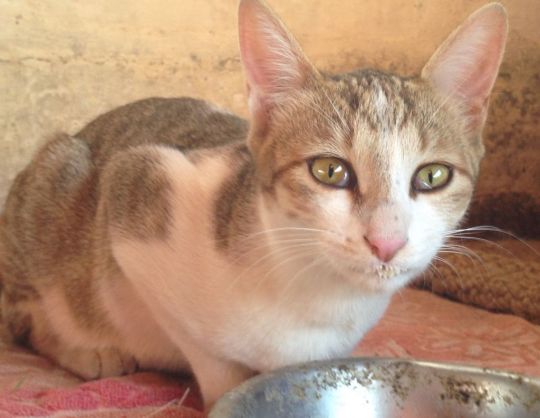
Enjoying a bowl of food provided by Ven. Gyalten Lekden on the roof of House 999, Sera Je Monastery, India, January 2017. Photo courtesy of Ven. Gyalten Lekden.
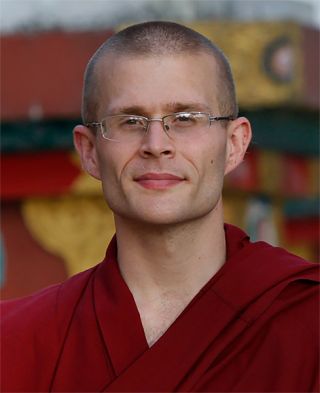
Ven. Gyalten Lekden
Ven. Gyalten Lekden, an International Mahayana Institute (IMI) monk who studies at Sera Je in South India, reports on some of his most beloved housemates. Cats. And more cats. The cats are strays that Ven. Lekden has taken to feeding and watching over, in keeping with Lama Zopa Rinpoche’s vast visions, which include caring for animals.
Usually between four and eight cats spend part of each day playing and lounging on the roof of House 999, where Ven. Lekden lives. Since they turn up their noses at local brands, he buys them imported cat food, and every day feeds the “clowder” (the official name for a group of cats) a few bowls of dry food, along with some eggs mixed into milk. He adds, smiling, “I spend more money on cat food than on my own food! But I feel happy doing it.” While setting out the food, he recites mantras and rubs bellies, meeting the kitties’ needs both in the moment and, hopefully, for the long term.

Cat napping on the robes of an unidentified monk, Sera Je Monastery, India, January 2017. Photo courtesy of Ven. Gyalten Lekden.
It started with just one, as these things do. Tom the Unnamed Tomcat arrived, and when it was cold Tom used to doze on Ven. Lekden’s lap while he recited or studied. When Tom got badly injured in a fight, Ven. Lekden cleaned his wounds and saved his life. Tom was later joined by a small female, Mama. After she had kittens, Ven. Lekden tried to save the weakest one, who Mama had abandoned, feeding her and naming her Tamdrin (Hayagriva), but she died after a few days. “She wouldn’t have lasted one night if I hadn’t taken her in,” says Ven. Lekden, “so hopefully she got some imprints and benefit. I gave her a fierce name so she could have a fierce spirit.”

Little Tamdrin wearing a coat made for her by Ven. Lekden, Sera Je Monastery, India, January 2017. Photo courtesy of Ven. Gyalten Lekden.
Soon other kittens started coming around. Says Ven. Lekden, “In addition to Mama and Tom we then had Mary Jane and her brother Sneaky Pete. My teacher, Geshe Chenga Tsering, who runs the house, advised I start feeding them on the roof. I moved their bowls up there, and when I got back from class one day he showed me a small lean-to he had built to keep them out the rain. I then made a small bed to put inside. Shortly thereafter, Mama had more kittens. These four are now my main customers. The boy is Big Red. The girls are Squeak, Pipsqueak, and Einstein. Tom still comes most days too. He just wanders around making noise until someone gives him attention or food.”
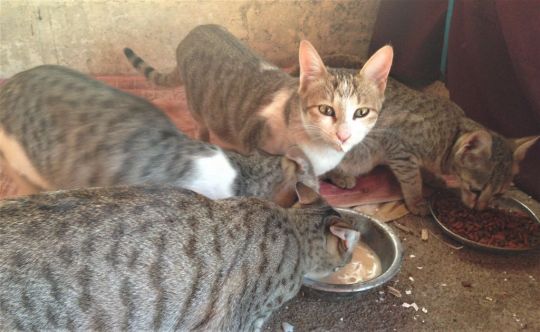
The “clowder” enjoying a meal at the feet of Ven. Lekden, Sera Je Monastery, India, January 2017. Photo courtesy of Ven. Gyalten Lekden.
The monks all like the cats, but the cats are wary of anyone but him, their main benefactor, says Ven. Lekden. Do they protect the house? “Not really,” he laughs. “Mice aren’t a problem here, and the rats are too big for the cats. I can’t see them going after the black cobras either. These guys are not very formidable foes … I don’t take care of them because they are useful. They’re hungry, and I have the means to help them, so I do.”
Watch Ven. Lekden on YouTube as he feeds and converses with the cats—and listen to them explain their side of the story too!
https://youtu.be/iqqTuiJiISo
Benefiting animals is one of Lama Zopa Rinpoche’s Vast Visions for FPMT:
https://fpmt.org/fpmt/vast-vision/#animals
For more about FPMT’s activities to benefit animals see:
https://fpmt.org/tag/animals/
Lama Zopa Rinpoche is the spiritual director of the Foundation for the Preservation of Mahayana Tradition (FPMT), a Tibetan Buddhist organization dedicated to the transmission of the Mahayana Buddhist tradition and values worldwide through teaching, meditation and community service.
- Tagged: animals, international mahayana institute, mantras, sera imi house, ven. gyalten lekden, video, video short
- 0
20
Paying Tribute to Geshe Pema Tsering
On February 11, 2017, Geshe Pema Tsering, who served as resident teacher at Buddha House in Adelaide, Australia, for nine years entered into clear light meditation after passing away. Mandala received this tribute to Geshe-la from Buddha House director Gabe Edwards on February 16, while Geshe-la was in his fifth day of clear light meditation:
It is with great sadness that we heard of the passing of most precious Geshe Pema Tsering, who was our resident teacher here at Buddha House from September 2001 to December 2010. He returned to Sera Je Monastery in December 2013 and remained there until his passing.
Geshe-la was born in 1939 in Dhargye Village in Kham province, Tibet, the only child of farming parents. He became ordained as a monk in Dhargye Monastery at the age of seven and at seventeen went to Sera Monastery in Lhasa where he met his spiritual teacher, Kyabje Khensur Kangyur Lobsang Thubten Rinpoche, who was also Buddha House’s former resident teacher, and continued his studies with the aim of getting his Geshe degree. He escaped to India at twenty years old following His Holiness the Dalai Lama’s departure from Tibet. Despite the hardships of traversing the snow covered mountains of the Himalayas, Geshe-la said his mind remained happy and buoyed by the positive spirit of his companions.
After ten years in a refugee camp in Buxa Duar, India, Geshe-la traveled to Karnataka in South India and for three years cleared the jungle and assisted in the re-establishment of Sera Je Monastery. He was thirty-three years old when he resumed his geshe studies under Khensur Rinpoche and Geshe Torche. In 1980 he achieve the highest level Geshe Lharampa degree.
Geshe-la had many students in Adelaide and India, and despite his high qualifications, he was widely known for his exceptional humility, kindness, and compassion.
As expressed by student Wendy Cook: “Geshe Pema Tsering passed away four days ago. Although he is considered clinically dead, he is, however, still in meditation, as his most subtle consciousness continues to reside in his body at his heart. The great yogis of Tibet who have committed their lives to deep practice and inquiry manifest this at the time of death. It is considered a very powerful time as one resides in the clear light with great wisdom and motivated by compassion for all beings. Geshe-la is in his final meditation at Sera Je Monastery in South India where the monks are engaged in practice, meditation, and chanting around the clock to support him in his transition. When his consciousness leaves the body, there will be signs, and then the monks will cremate Geshe-la’s body. This is how a great master of Tibet passes. Extraordinary. Without these precious lineage holders, the treasure of Tibetan Buddhism would not have been reestablished in India and then brought to the West.”
Ruth Gamble, scholar and translator for Geshe Pema Tsering while at Buddha House, so eloquently and poignantly expressed: “Gen-la always talked about impermanence. His mother died when he was young. In 1959 an artillery shell hit the room next to him killing his friend. Minutes later, he walked out of his home, and weeks later, he walked out of his country. He lost teachers and friends in refugee camps, and almost lost his thumb clearing the jungle in South India building a new monastery.
“But even in the midst of all this, he maintained a startlingly sharp sense of humor, fun, and wonder. His hero was a senior monk who told him that ‘the only things a monk needs are a sack and a rope, so it’s easy to get rid of his body when he dies.’ He thought this was a hilarious line. I guess his dark humor explains why he also found former prime minister John Howard and former president George W. Bush amusing: he seemed to think they were personally responsible for keeping the streets clean and the toilets flushing, so they can’t be all bad. He was fascinated by garbage trucks, sewerage works, and construction sites. They seemed to him, a farmer’s son who helped carve a monastery out of a jungle, as an ingenious magic show. He also loved soccer, but rather than barracking for a team, he barracked for a particular score: 3-3. That way, he said, no one felt sad about losing, but there were lots of goals.
“None of this (especially finding John Howard funny) is why he is my hero, though. He’s my hero because I saw him change his state of mind again and again. Rather than let anger, frustration, and jealousy—or even physical pain—shape his mind, he could transform his thoughts in an instant (or sometimes two). His anger would evaporate, his frustration would turn to patience, and his habitual compassion would reassert itself. The good thing about impermanence, he would say, is that it allows change.”
A complete obituary for Geshe Pema Tsering will be included as part of the July-December 2017 issue of Mandala.
- Tagged: geshe pema tsering, obituaries
- 0
19
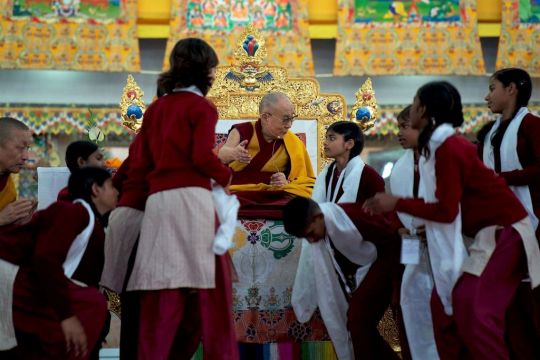
His Holiness talks with students from Maitreya School after their recitation, Bodhgaya, India, January 2017. Photo by Bill Kane.
Mandala has just published “His Holiness the Dalai Lama Gives His 34th Kalachakra Initiation,” an online feature—with plenty of great photos—about the Kalachakra initiation held recently in Bodhgaya, India, and FPMT’s involvement in it. This was the 34th such initiation His Holiness has granted and the fifth one in Bodhgaya, and more than 220,000 people attended, including students from FPMT centers around the globe. FPMT’s Root Institute for Wisdom Culture, set amidst beautiful grounds overflowing with statues and stupas, was filled with guests including Lama Zopa Rinpoche; Tenzin Ösel Hita; Yangsi Rinpoche; Cherok Lama; Tenzin Phuntsok Rinpoche; Tenzin Rigsel, the three-year-old reincarnation of the late Khen Rinpoche Lama Lhundrup; and other lamas and geshes, as well as many FPMT Sangha. Even actor Richard Gere was among the guests. A special team was put in place by Root Institute to coordinate FPMT’s involvement.

Kalachakra sand mandala, Bodhgaya, India, January 2017. Photo by Cynthia Karena
One particularly exciting moment for FPMT: students from FPMT’s Maitreya School in Bodhgaya were given the opportunity to recite the Heart Sutra in Sanskrit to His Holiness.
Ven. Tenzin Paldron, director of Root Institute, explained: “Dee Chandrashekhar, FPMT India’s national coordinator, had developed a tune for the Heart Sutra in Sanskrit and a couple of years ago Lama Zopa Rinpoche asked her to come and teach it to the Maitreya School children. She came last summer, and the children learned it. With their teacher they reviewed it on a regular basis, to the point where they felt confident. They were ready. Twelve girls and one boy sat in front of His Holiness and the whole audience and recited the Heart Sutra. They also offered a handmade placard with wishes for a happy 34th Kalachakra puja. It was historic; I don’t think children have recited the Heart Sutra in Sanskrit for His Holiness before. And they are very devoted when they recite—they do it with their full heart. His Holiness was deeply moved; he called it ‘wonderful’ and ‘inspiring.’ And he offered one hundred thousand rupees (US$1,500) to be used to take all 190 of the Maitreya School children on a picnic. The children were so happy!”
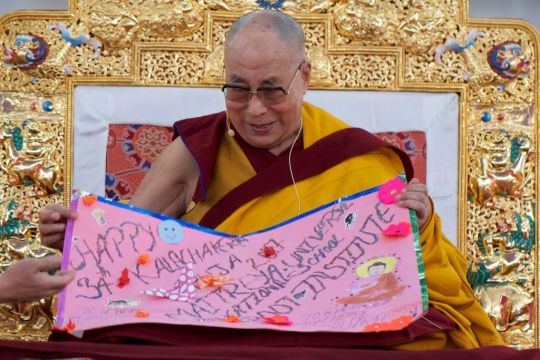
Hi Holiness examines the placard offering best wishes from the children of Maitreya School, Bodhgaya, India, January 2017. Photo by Bill Kane.
Read “His Holiness the Dalai Lama Gives His 34th Kalachakra Initiation,” Mandala‘s newest online feature:
https://fpmt.org/mandala/in-depth-stories/his-holiness-the-dalai-lama-gives-his-34th-kalachakra-initiation/
Mandala is offered as a benefit to supporters of the Friends of FPMT program, which provides funding for the educational, charitable, and online work of FPMT.
17
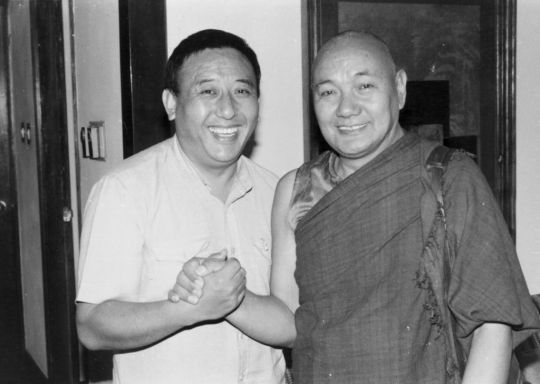
Gelek Rinpoche with Lama Yeshe at Rinpoche’s house. Lama Yeshe would go there to buy texts. Photo courtesy of Lama Yeshe Wisdom Archive.
It was with great sadness that we at FPMT International Office learned of the passing of Gelek Rinpoche (often spelled Gelek Rimpoche), founder of the Jewel Heart centers, on February 15, 2017. Rinpoche was a close friend of FPMT founder Lama Yeshe and spiritual director Lama Zopa Rinpoche.
Long-time student and director of Lama Yeshe Wisdom Archive Nicholas Ribush shares a personal reflection and some historical photos of Rinpoche from the Archive:
In January 1977, Lama Yeshe sent me to Delhi to start Tushita Mahayana Meditation Centre “in order to help repay the kindness of the Indian people to the Tibetans.” Lama explained that the Buddhadharma had come to Tibet from India, had largely been lost in India, had been preserved and developed in Tibet, and now was the time to reintroduce it to its land of origin.
It took a couple of years to find the right place but I eventually found a great house to rent in the lovely New Delhi suburb of Shantiniketan. During this period, in 1978, I first met Gelek Rinpoche at his home in Defence Colony, which was the base for his publishing many important Gelug texts and was where Lama Yeshe went to buy sets of these for his developing Western centers.
After we found the house for Tushita in 1979, Lama suggested I ask Gelek Rinpoche to teach, and he kindly accepted. That was the beginning of a seven-year collaboration between Rinpoche and Tushita. He was a wonderful teacher and connected with both Indian and Western students. I think it was as a result of the connections that Rinpoche made with some American students staying at Tushita (one of our functions was as a guest house for Westerners passing through Delhi) that led to Rinpoche being invited to the USA to teach and later to the establishment of his own organization, the Jewel Heart centers, starting in the late 1980s.
Rinpoche also actively participated in Tushita’s Dharma Celebrations. The first was held at the Oberoi Hotel and Rinpoche was one of the featured panelists. The guest of honor was supposed to be His Holiness the Dalai Lama but he couldn’t make it, so we got the home minister Giani Zail Singh, who later became president of India. Rinpoche was also a prominent guest at our Second Dharma Celebration, held at the Hotel Ashok.
Lama Yeshe and Lama Zopa Rinpoche used to pass through Delhi at least twice a year and would stay at Tushita. Most times Gelek Rinpoche would visit them on at least one of those visits and they would enjoy meals with him at the center or take him to one of Lama’s sister’s restaurants or to one of the five-star hotels around town.
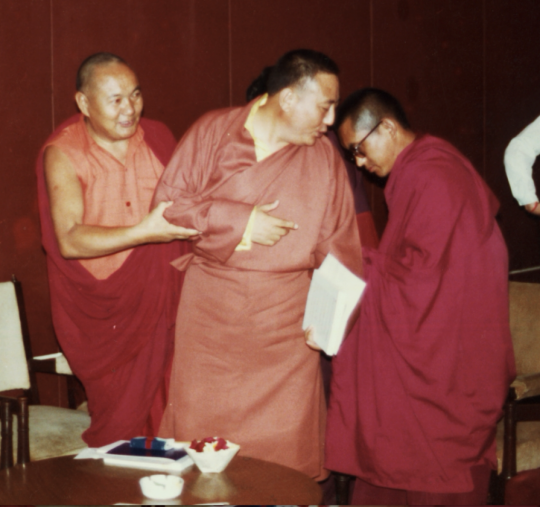
Lama Yeshe and Lama Zopa Rinpoche pushing Gelek Rinpoche into the top seat. Photo courtesy of Lama Yeshe Wisdom Archive.
After Rinpoche moved to the USA and I arrived soon after, I would meet him only occasionally and sometimes speak by phone, but I always felt a strong connection with him and rejoiced at the success of his Dharma work. Gelek Rinpoche’s passing is a great loss to his students, the Dharma, and the world.
Rinpoche’s official biography may be found on the Jewel Heart website.
An interview with Rinpoche appeared in Mandala in 1999:
https://fpmt.org/mandala/archives/older/mandala-issues-for-1999/may/gelek-rinpoche/
Rinpoche also talks about his early life in his book Good Life, Good Death. If you “look inside” the book on Amazon, you can read Robert Thurman’s very interesting introduction online.
A complete obituary for Gelek Rinpoche will be included as part of the July-December 2017 issue of Mandala.
- Tagged: gelek rinpoche, obituaries
- 0
10
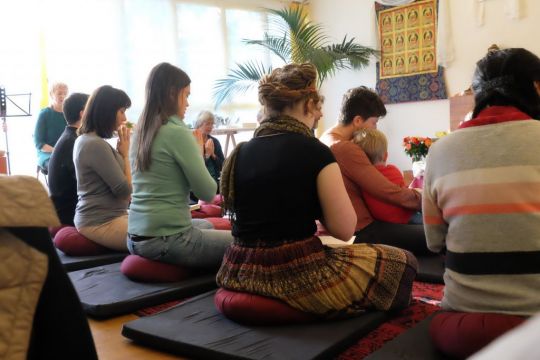
Student make prayers during Longku Center’s 15th anniversary, Bern, Switzerland, December 2016. Photo courtesy of Longku Center.
In December 2016, the students of Longku Center in Bern, Switzerland, celebrated their 15th anniversary. In attendance were a mix of old and new students, spanning Longku’s history. Director Jutta Mathä Dec shared the news with Mandala:
Although we were in the midst of a typical Swiss winter, the atmosphere was warm and bright inside our gompa. The day was a mixture of stories, reminiscences, sutra recitations, delicious food, amazing musical performances as well as the sharing of the work we have done on our website and logo.

Ven. Tsultrim (Ruth Hofer) offered a video message to students during Longku Center’s 15th anniversary, Bern, Switzerland, December 2016. Photo courtesy of Longku Center.
The center has its roots with Ueli Minder, who started a mixed-use Dharma space in Bern in 1993 that eventually became Longku Center. Several students unable to attend in person sent video messages, including founding director Ven. Tsultrim (Ruth Hofer); long-time students Gudrun Mathys and Heidi Haltmeier; previous directors Francesca Paoletti and Marianne Frischknecht; and Ven. Rita Riniker, who continues to both find the time to benefit us and teach throughout Europe and Israel. These messages were compiled by Eva Fuhrer (who also organized the celebration) with the help of Hanspeter Lut.
Also, present during the celebration were members of the other FPMT center here in Switzerland: director Jean-Paul Gloor of Gendun Drupa, with his ever-present smile, and of course a group of students from our satellite group in Zürich led by the tireless Nina and Jeff Highfill.
Marianne Müller gave a wonderful audio-visual presentation in the form of rhyming verses about her time at Longku, both as a student and current board member.
A wonderful treat for all of us were the celebratory musical performances! Our current joint SPCs, Lea Boesch and Manuel Oswald, are professional concert musicians, and with the addition of Marianne Müller on the recorder, we received a performance one would normally reserve for a classical concert.

Manuel Oswald, Lea Boesch, and Marianne Müller offer music during Longku Center’s 15th anniversary, Bern, Switzerland, December 2016. Photo courtesy of Longku Center.
The highlight of our day was a surprise personal message form Lama Zopa Rinpoche, who recorded a video for us in which he shared his vision of the role of the center in the modern world. He even sung us all “Happy Birthday,” a beautiful surprise for everyone.
Watch Lama Zopa Rinpoche’s birthday message (Part 1) to Longku Center on YouTube:
https://youtu.be/-f4itzCtcHk
Watch Lama Zopa Rinpoche’s birthday message (Part 2) to Longku Center on YouTube:
https://youtu.be/QX3ie6QOB48
To cap off the celebration day there was a lively presentation from the FPMT European coordinator Rafael Ferrer, who shared details of the Dharma and philanthropic activities of the FPMT organization. It was a good reminder that we are a part of a huge mandala of benefit in the world.
It has been such a fruitful 15 years shared together at Longku, spreading the vision of Lama Yeshe, Lama Zopa Rinpoche, and His Holiness the Dalai Lama for all numberless sentient beings. May we continue to create the causes and conditions for an eternity of blessings!
Mandala brings you news of Lama Zopa Rinpoche and of activities, teachings and events from nearly 160 FPMT centers, projects and services around the globe. If you like what you read on Mandala, consider becoming a Friend of FPMT, which supports our work.
4
On January 28, the Foundation for Developing Compassion and Wisdom (FDCW) hosted a talk by Tenzin Ösel Hita on “Educating the Heart.”
“And what a sweet treat it was,” said FDCW student Esther Garibay. “The last time I had the opportunity to spend time with Ösel was precisely at the 2011 Universal Education gathering, where he was mostly filming what later became the Being Your True Nature film. So I hadn’t really had an opportunity to hear him talk. Before the talk I felt curious and excited to hear this person I have been following on Facebook for years, but don’t really know that well.
“The atmosphere was electric as people gathered at the Jamyang lobby in expectation. Once the introductions were over and Ösel started to speak, I felt as if a magnet had pulled my attention toward him. His style is so direct and personal. Filled with anecdotes, stories, and wisdom that felt so relevant to my life and today’s world.
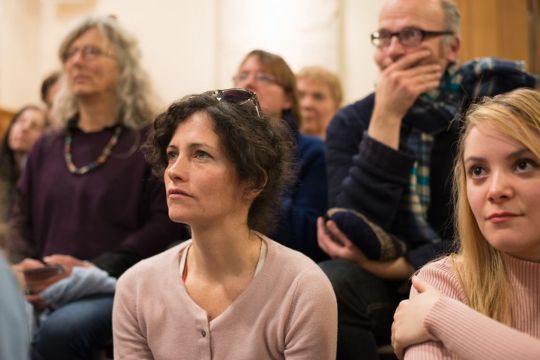
Students participate in a conversation with Tenzin Ösel Hita, Jamyang Buddhist Centre, London, UK, January 2017. Photo by Natasha Sturny.
“The talk started with a short meditation on gratefulness. ‘Everyday of our life, every morning that we wake up is like a rebirth, so everyday is a new life … but do we ever thank our heart or our lungs? Are we aware of the work they do?’ Ösel asked.
“With lightness and humor Ösel connected so easily to people, leading the talk as a conversation and inviting people to comment and answer questions. He covered such a wide range of themes: urban live, everyday kindness, forgiveness, inner values, the self-cherishing mind, and self-love, to name a few. He introduced us to the concept of inner gold: the more we have, the more we receive, and when we share it, that gold multiplies. And we don’t have to be afraid of losing it as it can’t be take from us.
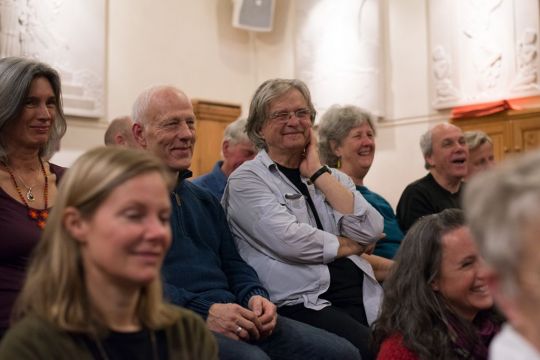
Students participate in a conversation with Tenzin Ösel Hita, Jamyang Buddhist Centre, London, UK, January 2017. Photo by Natasha Sturny.
“He ended the talk on the importance of believing in our potential and the importance of compassion: ‘If we have compassion then we would have no problems. Through compassion we can really transform problems. It is very important to have the wisdom but also the method, and that is what FDCW does, it brings out the compassion, the empathy we already have.’
“I felt so inspired and energized after his talk, and this sentiment was shared with every person I spoke to afterwards.”
Watch a recording of the live streamed event, courtesy of The Meridian Trust:
https://www.facebook.com/themeridiantrust/videos/10156055085419852/
https://www.facebook.com/themeridiantrust/videos/10156055085419852/
In 2016, Ösel attended Lama Zopa Rinpoche’s long life puja in Singapore; gave talks in Singapore, Malaysia, and Spain; and attended His Holiness the Dalai Lama’s teachings in Italy.
Ösel is currently giving talks at various FPMT centers in Europe. His schedule is: February 5—Aryatara Institut, Munich, Germany; February 11—Tong-nyi Nying-je Ling, Copenhagen, Denmark; February 15—Centre Kalachakra, Paris, France; February 17-19—Institut Vajra Yogini, Marzens, France; and March 25—Centro de Retiros O.Sel.Ling, Órgiva, Spain.
Please contact center directly for specific event information.
FPMT continues to support Ösel in all of his Dharma and educational endeavors through the Big Love Fund. All are welcome to be part of this offering.
You can learn more about Ösel including his biography, photos, videos and more
- Tagged: foundation for developing compassion and wisdom, jamyang buddhist centre, tenzin osel hita
- 0
3
In December 2016, Vajrapani Institute, an FPMT retreat center in Northern California, launched the 5 Trillion Mantra Prayer Wheel Project. The prayer wheel will contain 5 trillion (5,000,000,000,000) copies of OM MANI PADME HUM, the mantra of Chenrezig, the Buddhist deity who embodies universal compassion. The construction of the prayer wheel and its gazebo are scheduled for the end of 2018. The prayer wheel will be filled with 5 trillion mantras on microfilm in 2019.
In a short video, director Fabienne Pradelle articulates the vision of the 5 Trillion Mantra Prayer Wheel Project, sharing how prayer wheels inspire students and help sentient beings “purify and dissolve the negativities of [their] minds.”
Watch “5 Trillion Mantra Prayer Wheel Project” on YouTube:
https://www.youtube.com/watch?v=t06PB_KMjvo
“I feel really deeply grateful to have the opportunity to actually be part of this project,” Fabienne expresses in the video. “How often in your life do you have an opportunity to be part of something that you know is going to bring about benefit to so many beings? This is really a major contribution that Vajrapani Institute can offer to the wider community and the world at large.”
Supporting the creation of prayer wheels and other holy objects is part of Lama Zopa Rinpoche’s Vast Visions for FPMT:
https://fpmt.org/fpmt/vast-vision/#pw
Find out more and give your support to the 5 Trillion Mantra Prayer Wheel Project:
http://www.vajrapani.org/prayerwheel/pw/index.php
Mandala brings you news of Lama Zopa Rinpoche and of activities, teachings and events from nearly 160 FPMT centers, projects and services around the globe. If you like what you read on Mandala, consider becoming a Friend of FPMT, which supports our work.
- Tagged: prayer wheel, prayer wheels, vajrapani institute
- 0
13
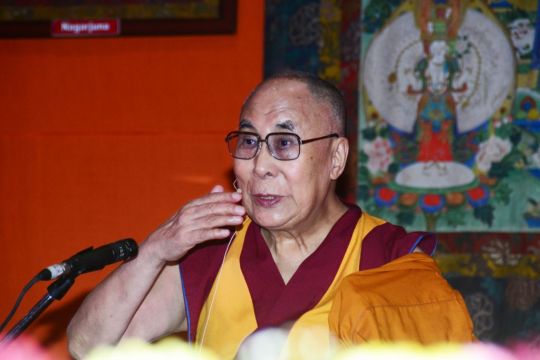
His Holiness the Dalai Lama giving a public talk at the 21st annual Dharma Celebration, New Delhi, India, December 2016. Photo by Subhash.
On December 11, 2016, Tushita Mahayana Meditation Centre hosted a public talk with His Holiness the Dalai Lama during its 21st annual Dharma Celebration at the Hotel Ashok in New Delhi, India. Director Prof. Renuka Singh shares highlights from the event:
His Holiness very graciously agreed to give a public lecture in English on the theme of “Compassion and Secular Ethics in the World Today.” FPMT founder Lama Yeshe and FPMT spiritual director Lama Zopa Rinpoche had initiated the Dharma Celebrations in Delhi, the first one held in 1981 at the same venue. His Holiness gave us two precious hours. We had over 1,500 attendees and were sorry that many people who arrived late or without an invitation card could not gain entry as the security was very stringent. Different groups of Indians, Tibetans and foreigners comprised our audience. Many high lamas and Sangha, important diplomats and bureaucrats, businessmen, academics, professionals, and students enjoyed and benefited from the talk.
Before the talk, Ven. Kabir Saxena, director of Maitreya Buddha Project Kushinagar, made a Powerpoint presentation on the project. In a private audience, His Holiness met with Lama Zopa Rinpoche and the project trustees, advising them to ensure the project becomes a vibrant center of Buddhist study and learning.
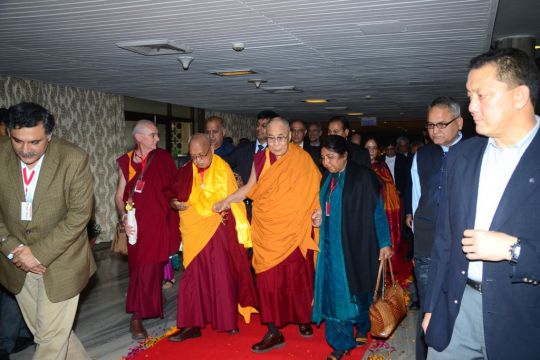
His Holiness the Dalai Lama, with Lama Zopa Rinpoche, FPMT CEO Ven. Roger Kunsang, and Prof. Renuka Singh, Dharma Celebration, New Delhi, India, December 2016. Photo by Subhash.
The welcome speech was given by the director, Prof. Renuka Singh, before His Holiness released two books on Guru Padmasambhava and Acharya Nagarjuna published by Wisdom Tree. It was unfortunate, Renuka asserted, that the Indian government, because of politics, was not taking advantage of His Holiness’s expertise in the formation and establishment of Nalanda University in Bihar today. She urged the authorities to give some thought to it.
His Holiness highlighted the facts that mentally, physically, and emotionally we are all the same. His discussions with the scientists over the last thirty years, especially in the context of destructive and positive emotions, reveal the fundamental compassionate nature of human beings. We are also social animals, so considering others as “us” and “them” prompts division and conflict that needs to be rectified.
After the suffering that marked the 20th century, His Holiness continued, we should make efforts not to repeat it. Money and military power won’t help. What is required of us is that we show affection to each other. Inter-religious harmony is His Holiness’s second commitment. He expressed regret that today traditions intended to be a source of tolerance and forgiveness have become grounds for conflict and killing. He also mentioned that just as Buddha taught differently according to his listeners’ interest, their capacity, and conditions, so a multitude of other religions have come about at different historical junctures.
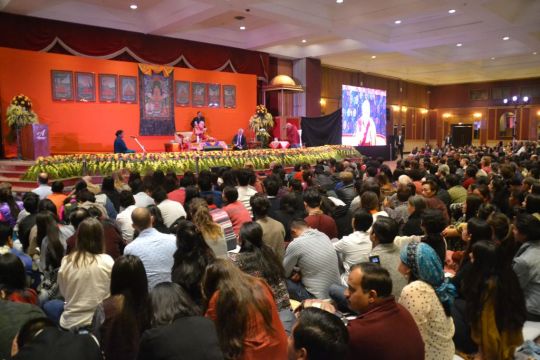
More than 1,500 people attended His Holiness’s talk at the 21st annual Dharma Celebration, New Delhi, India, December 2016. Photo by Subhash.
Even though His Holiness gave up his formal political role in 2011, as a Tibetan, he remains committed to the protection of the natural environment of Tibet and the preservation of the Tibetan language and culture. This culture is rooted in the Nalanda tradition of Buddhism that entails rigorous study and practice. He was heading towards South India to distribute the Geshema degrees to a group of nuns who had completed their Buddhist Studies—a significant achievement for the ordained nuns.
His Holiness also alluded to a reassessment of the contents of the Kangyur and Tengyur in terms of science, philosophy, and religion. His Holiness also spent half an hour answering several questions pertaining to “abundance,” different dimensions of reality, the way to make children more compassionate through education, and finally to having the desire of living an ordinary life. He recounted that once he was in retreat at the Potala Palace in the presence of the regent. In the evening, when the regent would fall asleep, His Holiness would hear the laughter and singing of children below the palace as they were returning home from grazing their animals. He momentarily wished to be like them. However, he later realized that his position as the Dalai Lama enabled him to benefit and serve Dharma and all sentient beings.
At the end, Lama Zopa Rinpoche gave heartfelt thanks to His Holiness and everyone who helped to make this event a success and presented a Dharmachakra to His Holiness. It was indeed a beautiful and meaningful celebration of Dharma, followed by tea. Buddhism has crossed bridges from century to century, decade to decade and has succeeded in changing the weltanschauung of people globally.
Finally, I thank all our sponsors, members of Tushita and our spiritual program coordinator Ven. Gyalten Samten for their contribution and effort that made this Dharma Celebration a great success.
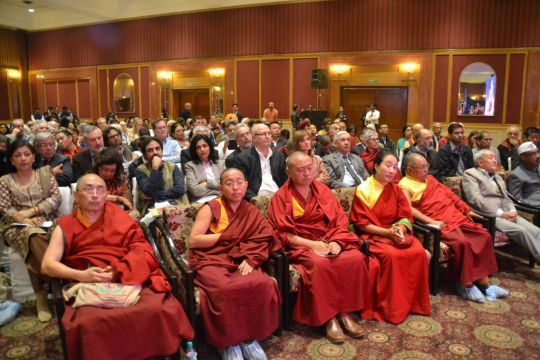
Many high lamas and dignitaries attended His Holiness’s talk, including Khadro-la (Rangjung Neljorma Khadro Namsel Drönme, front, fourth from right), Dharma Celebration, New Delhi, India, December 2016. Photo by Subhash.
Supporting His Holiness the Dalai Lama is one of Lama Zopa Rinpoche’s Vast Visions for FPMT: https://fpmt.org/fpmt/vast-vision/#hhdl
Mandala brings you news of Lama Zopa Rinpoche and of activities, teachings and events from nearly 160 FPMT centers, projects and services around the globe. If you like what you read on Mandala, consider becoming a Friend of FPMT, which supports our work.
- Tagged: tushita mahayana meditation centre
- 0
30
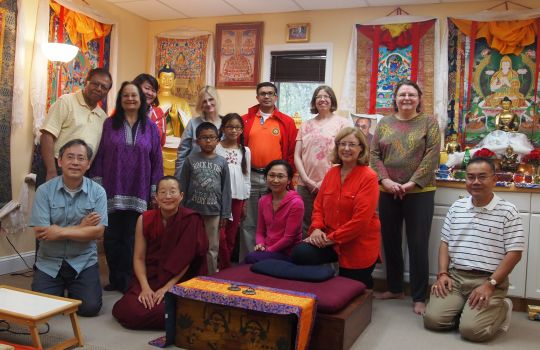
World Vegetarian Day, Guhyasamaja Center, Fairfax, Virginia, US, October 2016. Photo courtesy of Guhyasamaja Center.
On October 1, 2016, Guhyasamaja Center in the Washington DC Metro Area of the United States celebrated World Vegetarian Day. Guhyasamaja Center shared this report with Mandala to help encourage other FPMT centers to promote vegetarianism and veganism to their students:
Our World Vegetarian Day program combined the philosophy of vegetarianism with cooking tips and a delightful meal to demonstrate how vegetarian and vegan diets are simple, easy, and ethical. “Many people ask me how to practice Dharma in our daily lives,” said organizer Ven. Losang Tendrol. “One of the most beneficial practices is to stop eating other sentient beings.”
The North American Vegetarian Society founded World Vegetarian Day in 1977 to promote the joy, compassion, and life-enhancing possibilities of vegetarianism. In 1978, the International Vegetarian Union expanded the celebration to kick-off a month-long promotion of this healthier lifestyle.
Ven. Tendrol explored the Buddha’s teachings on the relationship between non-violence and eating meat. In the Hinayana and Vajrayana traditions, meat is only permitted in specific situations. Non-Vajrayana Mahayana teachings forbade meat altogether because a bodhisattva cannot develop authentic motherly love for all sentient beings while taking lives. Traditionally, the karma of eating meat is considered a shorter life and one rebirth in the hell realm for every animal consumed. Even vegetarianism involves killing and stealing, for example, as is done in the eggs, milk, and honey industries. Ven. Tendrol ended her talk with advice from Lama Zopa Rinpoche on how to eat meat if one’s health requires it.

Sample foods at World Vegetarian Day, Guhyasamaja Center, Fairfax, Virginia, US, October 2016. Photo courtesy of Guhyasamaja Center.
Animal rights activist Victoria Foote-Blackman offered a simplified approach to vegetarian and vegan cooking. “To be vegetarian or vegan is now very easy,” Victoria said. “Many healthy meat and dairy alternatives are readily available at grocery stores.”
Her engaging presentation included coupons for vegan products such as butter alternatives and recipes for easy, delicious meals. She introduced cookbooks and vegan products such as veggie burgers, soy milk, egg substitutes and even vegan ice cream.
The highlight of the celebration was, of course, the food! Victoria’s impressive menu offered sweet and sour seitan, a curried soy-based stir fry, rice noodles, veggies—and for dessert—whole wheat, apple sauce muffins and a vegan chocolate cheesecake! Ani Tendrol added a spicy, tomato dal curry. Participants so enjoyed the event that the ninety-minute program expanded to three hours of questions, lively discussion, and dining.
Dharma centers are a perfect setting for raising awareness about the disadvantages of consuming meat, from the health and environmental aspects to the ethical and karmic implications. Extensive Go Vegan! resources, with Dharma references, cooking instructions, and recipes, are posted on the Guhyasamaja Center blog. We encourage your center to plan its own vegetarian awareness event for the 2017 celebration.
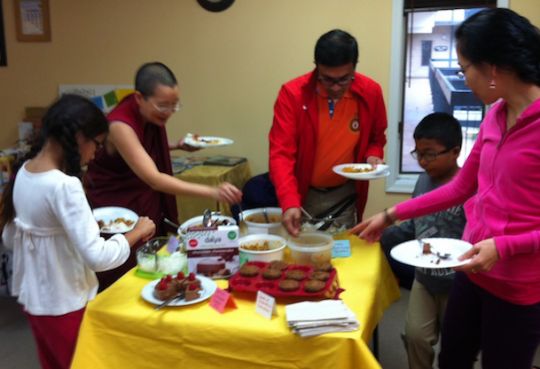
A healthy meal was part of World Vegetarian Day, Guhyasamaja Center, Fairfax, Virginia, US, October 2016. Photo courtesy of Guhyasamaja Center.
Read more about FPMT’s activities to encourage vegetarianism on FPMT.org:
https://fpmt.org/tag/vegetarianism/
Benefiting animals is one of Lama Zopa Rinpoche’s Vast Visions for FPMT:
https://fpmt.org/fpmt/vast-vision/#animals
Mandala brings you news of Lama Zopa Rinpoche and of activities, teachings and events from nearly 160 FPMT centers, projects and services around the globe. If you like what you read on Mandala, consider becoming a Friend of FPMT, which supports our work.
- Tagged: guhyasamaja center, veganism, vegetarianism, world vegetarian day
- 0
23
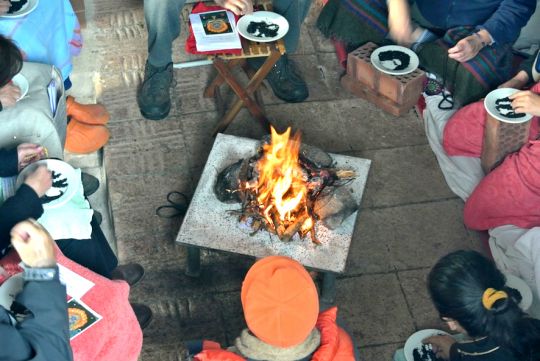
Dorje Khadro group retreat, Centro de Meditación Tushita, Arbúcies, Spain, October 2016. Photo courtesy of Annette van Citters.
“From September 29 until November 3, 2016, Centro de Meditación Tushita in Spain hosted a five-week Dorje Khadro group retreat that was attended by ten participants from all over the world,” reported student Annette van Citters. “Together we recited more than 1 million mantras, while offering 20 kilograms [44 pounds] of black sesame seeds mixed with genuine Spanish extra virgin olive oil into 50 kilograms [110 pounds] of charcoal and 2 cubic meters [71 cubic feet] of firewood.
“During the first few days of the retreat, Geshe Jamphel Gyaltsen from Nalanda Monastery, France, kindly gave teachings on the practice and the sadhana. We started each day with a morning session in the gompa doing prostrations to the 35 Confession Buddhas, Lama Chöpa with meditation on guru devotion, and Lama Tsongkhapa guru yoga. After that, we descended to the area below the gompa for the actual Dorje Khadro practice sessions, followed by lamrim meditations. We moved back to the gompa for dedications at the end of the day. The closeness between gompa and fireplace gave the whole Dorje Khadro practice a pleasant, intimate feel. As we were in the middle of the forest, there was plenty of firewood for us to use.
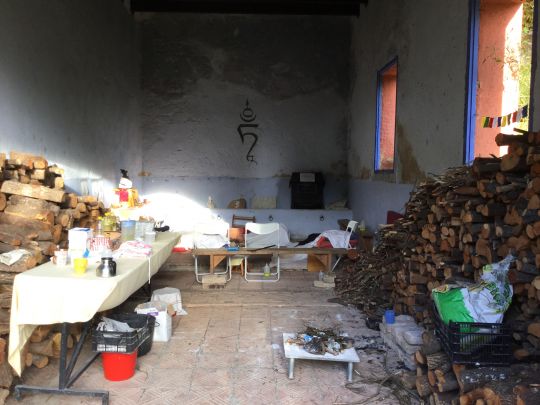
Dorje Khadro group retreat supplies, Centro de Meditación Tushita, Arbúcies, Spain, October 2016. Photo courtesy of Annette van Citters.
“The whole retreat was skillfully guided by Marina Brucet, a graduate of the FPMT Masters Program at Istituto Lama Tzong Khapa and current spiritual program coordinator at Tushita. Some sessions were guided by participants, which made for a very beautiful opportunity for everyone and a very good way of learning from each other. In addition, there was a team of warm-hearted volunteers who worked so hard to assist the participants in every possible way.”
“Once again, Tushita proved to be the perfect spot for a group retreat. Located on the edge of a national park on a mountain slope, there is an abundance of clean, crystal clear water. This water was used for the nine-day water bowl marathon in October 2015. The isolated quiet location (only birds and the occasional flock of sheep disturb the silence) and the spectacular open views make Tushita the perfect spot for the three-month Vajrasattva retreat organized there every other year.
“We dedicated our achievement to the long life of His Holiness the Dalai Lama, Lama Zopa Rinpoche, Tenzin Ösel Hita and all masters, and for all their wishes to come into fruition.”
Please visit the retreat schedule page on FPMT.org to find more information about major retreats scheduled at FPMT centers around the world. Also, find information about retreats with Lama Zopa Rinpoche, spiritual director of FPMT.
Mandala brings you news of Lama Zopa Rinpoche and of activities, teachings and events from nearly 160 FPMT centers, projects and services around the globe. If you like what you read on Mandala, consider becoming a Friend of FPMT, which supports our work.
- Tagged: centro de meditación tushita, dorje khadro, retreat
- 0
18
In early October 2016, Maitreya Buddha Project Kushinagar, a project to build a large statue of Maitreya Buddha in Kushinagar, India, announced that long-time student Ven. Kabir Saxena had taken over as director. Ven. Kabir wrote a letter to Maitreya Buddha Project Kushinagar supporters to make the announcement, which Mandala reproduces here in lightly edited form:
Dear respected friends,
I’m very happy indeed to have this opportunity to introduce myself as the new director of Maitreya Buddha Project Kushinagar.
I became involved with FPMT just after Easter 1977 in England during my studies in history at the beautiful university town of Oxford. Venerable Thubten Pemo, then living in England, was my first meditation instructor. I am so grateful to her.
My mother was English and father Indian, so I had a mix of both cultures, and since I opted for an Indian passport way back, I now stay in the land of my birth without visa hassles as I have been doing since 1983, when Lama Thubten Yeshe asked me to be director of Root Institute in Bodhgaya in order to help “repay the kindness of the Indian people.” Lama said he had faith in me and those words have sustained me in challenging times ever since.
During that early time Lama Yeshe shared with me his extraordinary vision for a large Maitreya Buddha statue or “Maitreya Project” as it later became known.
Now again in 2016, Kyabje Lama Zopa Rinpoche has again manifested faith in me for some inexplicable deeply hidden karmic reason by appointing me director of the Maitreya Project in Kushinagar, a project sixteen years in the making. These Maitreya Projects (there is another in Bodhgaya of course) were the heart-projects of Lama Thubten Yeshe, the founder of FPMT and Maitreya Project. I am deeply honored and humbled, and feel somewhat unworthy, and occasionally disoriented by the task ahead. I am, however, joyful at this opportunity to be of some benefit before I succumb to old age, decrepitude, and alas … death!
What we have set out to accomplish in Kushinagar is ambitious. It is a project with many spiritual, social, and economic facets. Apart from the large Maitreya Buddha statue to be set in a temple complex that also houses holy relics, we intend to create a Centre for Interfaith Dialogue; an Academy of Mind-Science as per His Holiness the Dalai Lama’s suggestion; educational facilities emphasizing the 16 Guidelines for a Happy Life; medical projects in the surrounding villages, as well as a quality hospital; a hospice; old people’s home; animal sanctuary; retreat area perhaps in the already wooded area; a permaculture pilot project; organic gardening; water conservation/harvesting; and waste management center … and there could be more! We also aim to lease some small parcels of land to other Buddhist like-minded organizations in a spirit of sharing and harmony.
India has seen a flight from the rural areas to the urban conglomerations, leading to debasement of life in both arenas. One major aim of mine is to restore the dignity of a useful, productive, and sustainable rural lifestyle at a time in India’s development when city life is becoming unbearable and competitively selfish. What the world needs more of now is cooperation and mutual aid as we face the results of more than 200 years of fast-paced industrial and technological development.
I intend the project to be the most inspiring, uplifting, and beautiful phenomenon that people will ever witness in their lives. I also intend to fulfill Rinpoche’s wish for the project to be “most beneficial” for all sentient beings as well as for it to help beings generate authentic loving-kindness in their minds.
For all this to happen we need not only your prayers and goodwill but also your continued generous and open-hearted support. Rinpoche has said this project will help FPMT to be more beneficial as well as contribute to more peace and harmony in North India and the world. We’ll all just have to do our very best!
I hope I can set a good and responsible example.
This is my heartfelt aspiration. I look forward to working with, and sharing this journey with, all of you—known and as yet unknown.
Thank you all so very much.
This letter was lightly edited by Mandala for inclusion on FPMT.org.
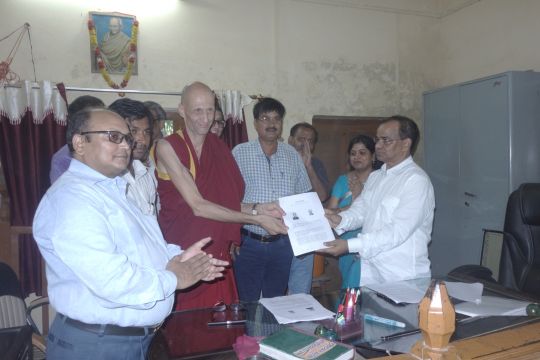
Ven. Kabir Saxena and the handover team at the registrar’s office in Kushinagar, UP, India. The land for the statue in Kushinagar was officially signed over by the state government of Uttar Pradesh, August 19, 2016. Photo courtesy of Maitreya Buddha Project Kushinagar.
Visit the Maitreya Buddha Project Kushinagar homepage to learn more and offer your support: http://mbpkushinagar.org/
Mandala brings you news of Lama Zopa Rinpoche and of activities, teachings, and events from nearly 160 FPMT centers, projects and services around the globe. If you like what you read on Mandala, consider becoming a Friend of FPMT, which supports our work.
- Home
- News/Media
- Study & Practice
- About FPMT Education Services
- Latest News
- Programs
- New to Buddhism?
- Buddhist Mind Science: Activating Your Potential
- Heart Advice for Death and Dying
- Discovering Buddhism
- Living in the Path
- Exploring Buddhism
- FPMT Basic Program
- FPMT Masters Program
- FPMT In-Depth Meditation Training
- Maitripa College
- Lotsawa Rinchen Zangpo Translator Program
- Universal Education for Compassion & Wisdom
- Online Learning Center
- Prayers & Practice Materials
- Overview of Prayers & Practices
- Full Catalogue of Prayers & Practice Materials
- Explore Popular Topics
- Benefiting Animals
- Chenrezig Resources
- Death & Dying Resources
- Lama Chopa (Guru Puja)
- Lama Zopa Rinpoche: Compendium of Precious Instructions
- Lama Zopa Rinpoche: Life Practice Advice
- Lama Zopa Rinpoche Practice Series
- Lamrim Resources
- Mantras
- Prayer Book Updates
- Purification Practices
- Sutras
- Thought Transformation (Lojong)
- Audio Materials
- Dharma Dates – Tibetan Calendar
- Translation Services
- Publishing Services
- Teachings and Advice
- Find Teachings and Advice
- Lama Zopa Rinpoche Advice Page
- Lama Zopa Rinpoche: Compendium of Precious Instructions
- Lama Zopa Rinpoche Video Teachings
- ༧སྐྱབས་རྗེ་བཟོད་པ་རིན་པོ་ཆེ་མཆོག་ནས་སྩལ་བའི་བཀའ་སློབ་བརྙན་འཕྲིན།
- Podcasts
- Lama Yeshe Wisdom Archive
- Buddhism FAQ
- Dharma for Young People
- Resources on Holy Objects
- Ways to Offer Support
- Centers
- Affiliates Area
- Teachers
- Projects
- Charitable Projects
- Make a Donation
- Applying for Grants
- News about Projects
- Other Projects within FPMT
- Support International Office
- Projects Photo Galleries
- Give Where Most Needed
- FPMT
- Shop
Subscribe to FPMT News
Translate*
*powered by Google TranslateTranslation of pages on fpmt.org is performed by Google Translate, a third party service which FPMT has no control over. The service provides automated computer translations that are only an approximation of the websites' original content. The translations should not be considered exact and only used as a rough guide.In my mind, one of the beauties of Buddhism is that it offers us a practical training for our mind. It does not say, ‘Bodhicitta is fantastic because Buddha said so!’ Instead, it gives us the methods for developing such an attitude and we can then see for ourselves whether it works or not, whether it is fantastic or not.







